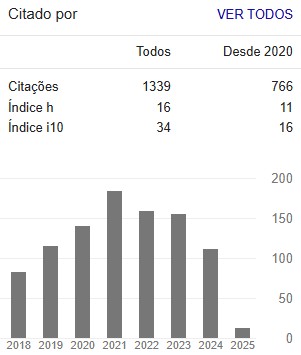CORRELATION BETWEEN BASAL METABOLIC RATE AND HEART RATE VARIABILITY IN FUNCTIONAL RESISTANCE TRAINING IN SUBJECTS WITH METABOLIC SYNDROME
Keywords:
síndrome metabólica, exercício, sistema nervoso autônomo, metabolismo basalAbstract
Physical exercise is a non-pharmacological alternative to act on the indicators of the metabolic syndrome (MS). Functional resistance training (FRT), recruits a greater number of muscle groups, which can lead to greater energy expenditure. Therefore, the aim of this study was to analyze the correlation between the basal metabolic rate (BMR) and the heart rate variability (HRV) in FRT in individuals with MS. The study was a non-randomized clinical trial consisting of 32 subjects who had MS who were divided into functional resistance training group (FRTG) and control group (CG). The HRV was collected with a cardiofrequency meter and the vagal indices were selected and for the analysis of BMR was performed by bioimpedance. Correlation was observed for the HF index with BMR only prior to FRT. Therefore, there is no significant correlation between vagal indices and BMR in individuals with MS after performing RFT.
Downloads
References
Malambo P, Kengne AP, de Villiers A, Lambert EV, Puoane T. Built environment, selected risk factors and major cardiovascular disease outcomes: a systematic review. PloS One. 2016;11(11):e0166846. DOI: https://doi.org/10.1371/journal.pone.0166846
Rennie KL, McCarthy N, Yazdgerdi S, Marmot M, Brunner E. Association of the metabolic syndrome with both vigorous and moderate physical activity. Int J Epidemiol. 2003;32(4):600-6. DOI: https://doi.org/10.1093/ije/dyg179
Gustat J, Srinivasan SR, Elkasabany A, Berenson GS. Relation of self-rated measures of physical activity to multiple risk factors of insulin resistance syndrome in young adults: the Bogalusa Heart Study. J Clin Epidemiol. 2002;55(10):997-1006. DOI: https://doi.org/10.1016/S0895-4356(02)00427-4
Pereira Junior M, Andrade RD, Silveira FV, Baldissera UM, Korbes AS, Navarro F. Exercício físico resistido e síndrome metabólica: uma revisão sistemática. RBPFEX. 2013;7(42):529-39.
Cabral CC, Giacon TR, Campos EZ, Neto JG, Rodrigues B, Vanderlei LCM, et al. Impact of high-intensity intermittent and moderate intensity continuous exercise on autonomic modulation in young men. Int J Sports Med. 2016;37(6):431-5. DOI: https://doi.org/10.1055/s-0042-100292
Miranda JMQ, Dias LC, Mostarda CT, Angelis KD, Figueira Junior AJ, Wichi RB. Efeito do treinamento de força nas variáveis cardiovasculares em adolescentes com sobrepeso. Rev Bras Med Esporte. 2014;20(2):125-30. DOI: https://doi.org/10.1590/1517-86922014200201703
Pumprla J, Howorka K, Groves D, Chester M, Nolan J. Functional assessment of heart rate variability: physiological basis and practical applications. Int J Cardiol. 2002;84(1):1-14. DOI: https://doi.org/10.1016/S0167-5273(02)00057-8
Wolf MM, Varigos GA, Hunt D, Sloman JG. Sinus arrhythmia in acute myocardial infarction. Med J Aust. 1978;2(2):52-3.
Cabral CC, Giacon TR, Campos EZ, Neto JG, Rodrigues B, Vanderlei LCM, et al. Impact of high-intensity intermittent and moderate intensity continuous exercise on autonomic modulation in young men. Int J Sports Med. 2016;37(6):431-5. DOI: https://doi.org/10.1055/s-0042-100292
Hopkins WG. Measures of reliability in sports medicine and science. Sports Med. 2000;30(1):1-15. DOI: https://doi.org/10.2165/00007256-200030010-00001
Mehta RK. Impactos da obesidade e estresse no desenvolvimento da fadiga neuromuscular e variabilidade da frequência cardíaca associada. Int J Obes. 2015;39:208-13. DOI: https://doi.org/10.1038/ijo.2014.127
Farah BQ, Prado WLd, Tenório TRdS, Ritti-Dias RM. Relação entre variabilidade da frequência cardíaca e indicadores de obesidade central e geral em adolescentes obesos normotensos. Einstein (São Paulo). 2013;11(3):285-90. DOI: https://doi.org/10.1590/S1679-45082013000300005
Rossi RC, Vanderlei LCM, Gonçalves ACCR, Vanderlei FM, Bernardo AFB, Yamada KMH, et al. Impact of obesity on autonomic modulation, heart rate and blood pressure in obese young people. Auton Neurosci. 2015;193:138-41. DOI: https://doi.org/10.1016/j.autneu.2015.07.424
Meirelles CM, Gomes PSC. Efeitos agudos da atividade contra-resistência sobre o gasto energético: revisitando o impacto das principais variáveis. Rev Bras Med Esporte. 2004;10(2):122-3. DOI: https://doi.org/10.1590/S1517-86922004000200006
. Melby C, Scholl C, Edwards G, Bullough R. Effect of acute resistance exercise on post exercise energy expenditure and resting metabolic rate. J Appl Physiol. 1985;75(4):1847-53. DOI: https://doi.org/10.1152/jappl.1993.75.4.1847
Barbosa MPCR, Júnior JN, Cassemiro BM, Souza NM, Bernardo AFB, Silva AKF et al. Impact of functional training on cardiac autonomic modulation, cardiopulmonary parameters and quality of life in healthy women. Clin Physiol Funct Imaging. 2016;36:318-25. DOI: https://doi.org/10.1111/cpf.12235
Durstine JL, Haskell WL. Effects of exercise training on plasma lipids and lipoproteins. Exerc Sports Sci Rev. 1994;22:477-521. DOI: https://doi.org/10.1249/00003677-199401000-00017
Vinik ai, maser re, ziegler d. neuropathy: the crystal ball for cardiovascular disease? Diabetes Care. 2010;33(7):1688-9. DOI: https://doi.org/10.2337/dc10-0745
Sandercock GR, Brodie DA. The role of heart rate variability in prognosis for different modes of death in chronic heart failure. Pacing Clin Electrophysiol. 2006;29(8):892-904. DOI: https://doi.org/10.1111/j.1540-8159.2006.00457.x
Downloads
Published
Issue
Section
License
Os artigos submetidos à revista Colloquium Vitae estão licenciados conforme CC BY-NC-ND. Para mais informações sobre essa forma de Licenciamento, consulte: http://creativecommons.org/licenses/by-nc-nd/4.0/.
A disponibilização é gratuita na Internet, para que os usuários possam ler, fazer download, copiar, distribuir, imprimir, pesquisar ou referenciar o texto integral dos documentos, processá-los para indexação, utilizá-los como dados de entrada de programas para softwares, ou usá-los para qualquer outro propósito legal, sem barreira financeira, legal ou técnica.

